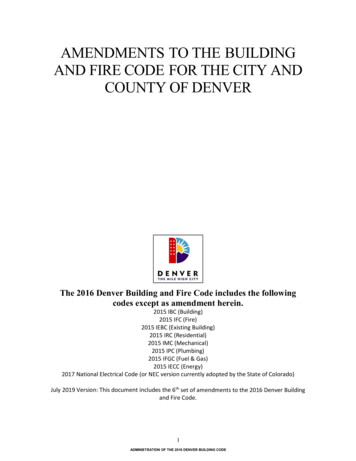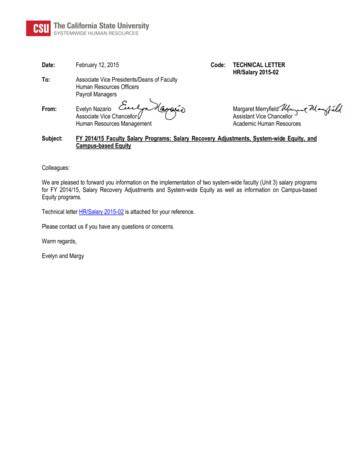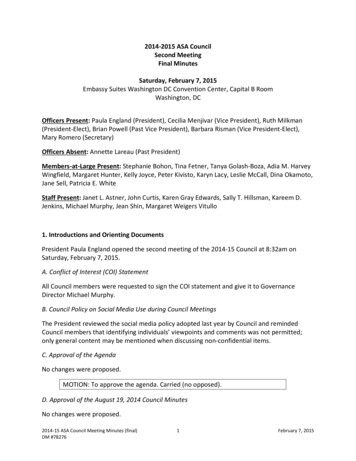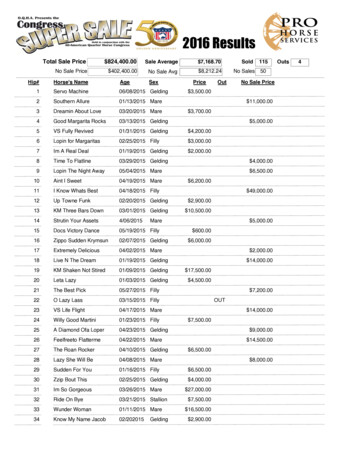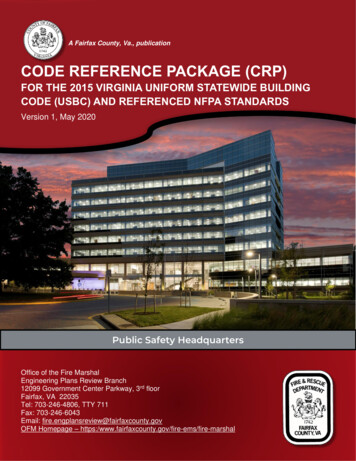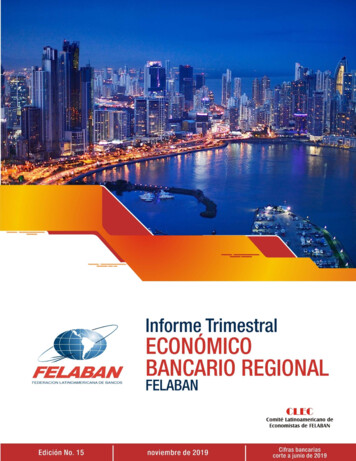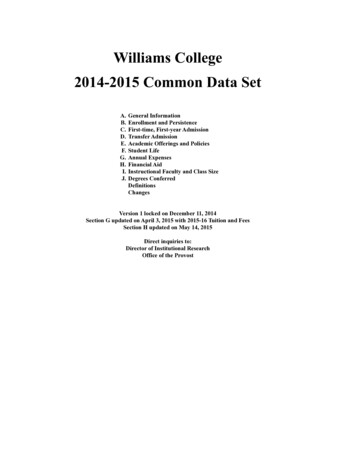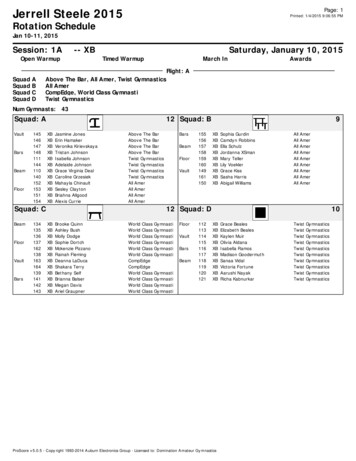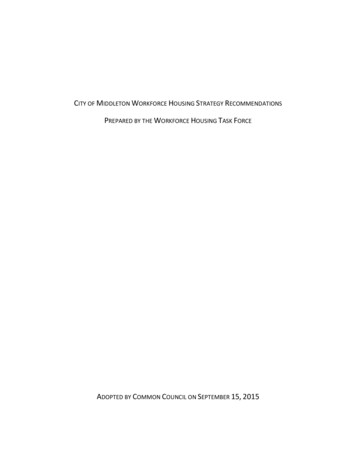
Transcription
CITY OF MIDDLETON WORKFORCE HOUSING STRATEGY RECOMMENDATIONSPREPARED BY THE WORKFORCE HOUSING TASK FORCEADOPTED BY COMMON COUNCIL ON SEPTEMBER 15, 2015
INTRODUCTIONThe City of Middleton was named one of Money Magazine’s “Best Places to Live” in 2011. Middleton is agrowing and thriving city, with a high quality of life and growing economic development. Over 8,000 peoplecommute into Middleton to work each day, and over 1,000 new jobs are planned to come to Middleton within afew years.The Workforce Housing Task Force was established by former Mayor Doug Zwank in 2007 to explorerecommendations for furthering the availability of workforce housing in the City of Middleton.The Workforce Housing Task Force advances these Housing Strategy recommendations with the goal ofsupporting the growth of Middleton as an emerging job center by “encouraging compact development and amixed-income and diverse community where people who work in Middleton are able to afford to live inMiddleton.”The City of Middleton Workforce Housing Task Force has closely followed the development of the DaneCounty Housing Needs Assessment that was adopted by the County Board in January 2015. This “NeedsAssessment” includes demographic and housing data about the municipalities in Dane County. Excerpts of theHousing Needs Assessment – which contains the best and most current data available - are shown on the nextfew pages. The availability of new data and an increased demand for affordable housing in Middleton make thisa critical time to address these housing goals.Since its inception, the Workforce Housing Task Force has: Drafted and received approval for an exemption of impact fees for low-cost housing.Administered a down payment assistance program (DPAP) funded by the Community DevelopmentAuthority (CDA) which provided down payment assistance loans to 18 households with incomesbetween 40-80% of Dane County’s median income. Of the loans, 14 are still active.Partnered with the Dane County Housing Authority (DCHA) to provide employer outreach inMiddleton to determine the housing needs and locate appropriate partner organizations.Submitted unsuccessful funding applications for Home Investment Partnership Initiative (HOME) andHousing Cost Reduction Initiative (HCRI) funding to support DPAP.Negotiated a workforce housing agreement with Hidden Oaks (Veridian Homes), which wasdiscontinued due to the economic downtown and reduced sales prices without the workforce housingsubsidy.Negotiated a workforce housing agreement with Whispering Pines (Ellefson Companies) forcondominium homes at prices affordable to households earning 80% or less of Dane County’s medianincome. Of the 33 units sold, 9 have been qualified under the 80% income threshold. Staff continues tomonitor compliance with this agreement annually.Supported the development of Parmenter Circle Phase I, which includes 40 units of affordable rentalhousing for residents earning between 30-80% of the Dane County median income.Supported the development of the Heritage Middleton Senior Housing Campus, which includes 56 unitsof affordable rental housing for elderly residents earning less than 60% of the Dane County medianincome.
Staff continues to monitor compliance with a workforce housing agreement for The Elmwood, whichrequires a set aside of units affordable to renters earning less than 80% of the Dane County medianincome. This agreement was negotiated in exchange for a deferral of parkland fees.Continue to support the development of Meadow Ridge Apartments, which is planned to include 76units of affordable rental housing for residents earning below 60% of the Dane County median income.Prepared recommendations and supported the redevelopment of 10 blighted duplex units into 10 singlefamily homes on Amherst Road.WORKFORCE HOUSING STRATEGYThe Dane County Housing Needs Assessment identifies a present affordable housing “gap” or “need” ofbetween 295 to 795 units in the City of Middleton. 295 units represents the gap between the number of verylow income households currently living in Middleton and the number of units which would be affordable tothese households. 795 units represents the number of “cost-burdened1” very-low income2 renter households(paying more than 30 percent of their income in rent) currently residing in Middleton.The Workforce Housing Task Force recommends that the City of Middleton adopt a goal to encourage,facilitate, and support affordable homeownership for families earning up to 80% of the AMI and to increaseMiddleton’s supply of affordable housing units by at least 295 units in the next 3-5 years. This supply ofaffordable housing can come either through new construction or through rehabilitation of existing units (withsubsidies attached).Developers seeking residential developments in the City are expected to align their strategies with the City’sComprehensive Plan and incorporate workforce housing for families earning up to 80% of the area medianincome (AMI).The Workforce Housing Task Force recommends the following strategies and policies to increase the supply ofaffordable housing in Middleton.1. Encourage the establishment of a revolving loan fund (RLF) for smaller projects servingfamilies earning less than 80% of the County Median Income (CMI), such as rehabilitation ofowner occupied housing and/or down payment assistance loans for new home owners.2. Utilize tax increment district (TID) 3 and 5 funding for affordable workforce housing to matchother funding sources. Encourage that all residential projects receiving a tax increment financing(TIF) subsidy have a percentage of affordable units.3. Incentivize housing developers to include workforce housing units in new developments, throughthe use of TID 3 and 5 funding, through impact fee waivers, through the deferral of parklandfees, and through possible reductions in required number of parking spaces for affordable units4. Develop a program that will assist low-income seniors to stay in their homes longer (providingenergy efficiency upgrades, assistance with home repairs, etc.).1When families pay more than 30% of their income for housing, this means that other important household expenditures such asfood, health care, education, and transportation are negatively impacted. In housing needs analyses, households who pay more than30% of their income for housing are called “cost-burdened” households.2Very low income households are those defined as making 50 percent of area-median-income or less.
5. Work aggressively to seek State (LIHTC, etc.) and County funding (CDBG, HOME, TheAffordable Housing Development Fund) for private (including non-profit) affordabledevelopment projects and rental rehabilitation projects in Middleton.6. Encourage production of affordable housing in or near those areas identified by WHEDA(Wisconsin Housing and Economic Development Authority) as “High Need” or “EmploymentCenter” Census-tracts (see map on following page).7. Work with developers to provide support for affordable housing projects (includingrecommendations for available land, financing sources, and letters of support).8. Promote and support the Dane County Housing Authority’s programs and services.9. Partner with the Dane County Homebuyer’s Roundtable and other organizations to provideaccurate public informational materials about affordable options, including a guide to programsavailable from area financial institutions.10. Update the Comprehensive Plan Housing Element with new data on the need for housing inDane County and goals for workforce housing creation.11. Update the Comprehensive Plan Housing and Land Use Elements to examine and promote anadequate “availability of land for the development or redevelopment of low–income andmoderate–income housing.” (Wis. Stat. § 66.1001(2)(b)).12. Develop criteria for and a listing of potential workforce housing sites.13. Develop a task force that includes Plan Commission and Workforce Housing Task Forcemembers to explore long-term affordable homeownership.14. Explore small lots and flexible design standards to encourage smaller, more affordable,homeownership opportunities.
DANE COUNTY HOUSING NEEDS ASSESSMENTExcerpts of the Dane County Housing Needs Assessment are shown below. This is a sampling of the tables thatare included in the report. The full report can be found g Needs Assessment 01152015.pdf.Key findings from the report are as follows:1. The growing diversity of household types – including seniors and single-person households –requires a diverse housing supply in terms of unit sizes and locations.2. Madison has less than 48 percent of the county’s population, and houses 73 percent of thecounty’s extremely low-income renter households.3. Madison and Dane County housing markets are relatively expensive compared to the rest of thestate and the nation.4. Rental housing vacancy rates are extremely low. (The most recent vacancy rate informationavailable from MGE shows Middleton’s vacancy rate at 1.08%. cancy-rates/)5. The main rental housing affordability challenge is for very low income households (thosedefined as making 50 percent of area median income or less).6. In Dane County, over 22,000 households with very low income pay more than 30 percent of theirincome in rent. Over 12,000 very low income households pay more than 50 percent of theirincome in rent. Of these 12,000 “severely cost burdened” households, over 2,200 are seniorhouseholds.7. Forecasts of future affordable housing needs indicate that Dane County’s need for affordablehousing units could be somewhere between 16,000 and 31,000 in the next 26 years, or between648 and 1209 affordable units each year.
In Table 1.2, the most recent (FY14) income category cutoffs by HUD for different AMI (area median income) levels forDane County (including Madison) are presented. In Table 1.3, these income levels are shown as “affordable” monthlyhousing costs (spending no more than 30 percent of income on “gross rent.”) For example, a family of 3 people withincome at 30-percent-of-AMI ( 21,850) would need to find rental housing for 546 per month (including utilities) tobe considered affordable.In Table 1.4, we present data on the “starting” wages (10th percentile) and median (middle) wages for a number ofselected occupations. These occupations include categories such as teachers, police officers, nurses, retail workers,drivers, and construction and landscape workers. These occupations are just a sample of different types ofoccupations to illustrate the relationships between income and housing affordability. For each occupation, Table 1.4shows the maximum affordable “gross rent” (rent utility costs) for that wage level. It also shows the price of a housewhich that income level could potentially afford with an FHA mortgage (3 percent down-payment) with a 30-yearfixed rate, with calculations and adjustments for property taxes and home insurance.
Table 2.1 presents some basic demographics of each Dane County community, including homeownership rates andindicators of housing demand (over age 65, households with children present, and single-person households.)Table 2.2 reports data on the distribution of racial and ethnic categories across municipalities. This table focuses onthree categories: non-Hispanic White, African-Americans (non-Hispanic) and persons of Hispanic or Latino origin.These categories are what is reported in HUD’s data and may not reflect the full diversity of communities.
“Table 3.2 focuses on those households more likely to have housing affordability concerns. The measuresof potential need include households at or below the federal poverty line (FPL), and households at 30 and50 percent of area median income, respectively. Rather than reporting raw numbers, Table 3.2 indicateseach municipality’s percent of the county’s overall population in each category. The relative balance oflower-income households across communities reflects the availability of a range of housing choices oftypes, sizes and prices. The type of analysis shown in Table 3.2 is used in other states to examine what canbe called “regional balance” or “fair share.”Table 4.2 presents the median value of owner-occupied housing and the contract rents for units in Dane Countycommunities in 2010.
Table 6.1 shows the percentage of ownership and rental units in each municipality which are affordable at differentincome levels.In Table 6.2 we present this “affordable needs gap” for each municipality in the county. (As above, this calculationonly examines the actual number of households at 30 or 50 percent of AMI already residing in each municipality, notthe broader number of 30 and 50 percent AMI households in the county who would otherwise want to live in eachcommunity if additional housing opportunities were available.)
Table 7.1 shows the number and percentage, by municipality, of households with income 30 and 50 percent of AMIwho currently pay more than 30 percent of their income on housing costs ( “cost burdened”). When families paymore than 30 percent of their income for housing, this means that other important household expenditures such asfor food, health care, education, and transportation are negatively impacted. In housing needs analyses, householdswho pay more than 30 percent of their income for housing are called “cost-burdened” households.
In Table 9.1 we show the number of cost burdened lower-income senior households (both renters and owners) ineach municipality. Recall the households who pay more than 30 percent of their income on housing costs areconsidered “cost-burdened” while households who pay more than 50 percent of their income on housing areconsidered “severely cost-burdened.” These data only represent those households who currently reside in eachmunicipality.
5. The main rental housing affordability challenge is for very low income households (those defined as making 50 percent of area median income or less). 6. In Dane County, over 22,000 households with very low income pay more than 30 percent of their income in rent. Over 12,000 very low income households pay more than 50 percent of their income .
